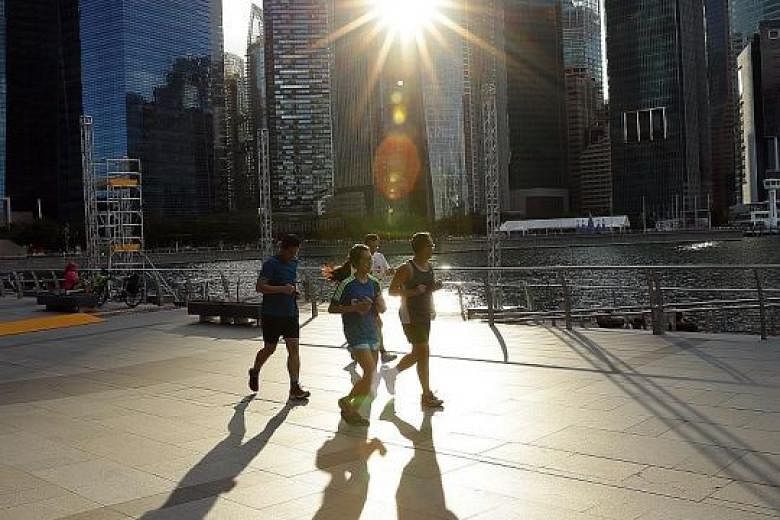On Monday, Singapore was exposed to "extreme" ultraviolet (UV) levels, with the highest one-hour average UV index of 15 recorded at 1pm and 2pm, according to the Meteorological Service Singapore (MSS).
This extreme level was also recorded last Tuesday, and on Sept 8 and 17 last year.
While experts say these isolated incidents are not a major cause for concern, they add that precautions should be taken when staying out in the sun, especially between 10am and 3pm, when sun intensity peaks and UV radiation is strongest.
National Environment Agency (NEA) data shows Singapore experiences high levels of UV radiation year round, averaging six to nine on the daily maximum UV Index. This is because of its proximity to the equator, which puts the sun directly overhead most of the year, said Dr Abel Yang, physics lecturer at the National University of Singapore.
"We receive more direct sunlight which passes through less atmosphere, which means less UV radiation gets absorbed," he said. Other factors such as the amount of cloud cover also affect radiation levels.
The UV Index - an international standard measurement of the level of UV radiation - ranges from 0 to 11+, and is grouped into various categories, from low to extreme.
Extra protection against sunburn is needed when the value hits "very high" levels of between eight and 10, and "extreme" levels of 11 and above, according to the NEA website.
Over the past two weeks, Singapore has experienced some of the highest UV Index values recorded, including 12 last Friday, 13 last Saturday and Sunday, 15 on Monday and 14 on Tuesday.
A high UV Index reading means a larger dose of UV radiation for the same amount of time spent in the sun, said Dr Koh Hong Yi, dermatology consultant at the Singapore General Hospital. This could lead to ailments such as skin cancer, pigmentation and premature ageing of the skin in the long term.
Sun protection is especially crucial for those with fair complexions, who have poorer immunity or medical conditions such as lupus that increase their sensitivity to UV, added Dr Koh.
A blanket solution would be to apply sunscreen, which blocks out both UVA and UVB rays, of at least SPF 30 every two hours.
Carrying an umbrella and wearing a broad-brimmed hat and sunglasses that block UVA/UVB rays also cut down on UV exposure.
A PCF Sparkletots spokesman said outdoor activities typically take place before 11am and after 4pm, and children are encouraged "to wear caps and apply sunscreen as well as stay well hydrated by drinking plenty of water".
Marketing intern Angela Goh, 21, has made sunscreen a part of her skincare routine. She previously banked on an SPF-infused foundation for sun protection.
"I actually do have stronger sunblock, I just never used it because I didn't see the need to," she said.
How to protect yourself properly
Stay out of the sun
UV levels are at their highest from 10am to 3pm.
If you have to be outdoors at this time, use sunscreen of at least sun protection factor (SPF) 30, carry an umbrella and wear a broad-brimmed hat and sunglasses that block UVA/UVB rays.
As a guide, re-apply sunscreen every two hours, with more frequent re-application under strong sunshine.
Choose the right sunblock
The minimum recommendation for daily sun protection is SPF 30, with a PA level of +++, according to the American Academy of Dermatology.
Higher SPF ratings mean greater protection from UVB rays (short-wave rays which damage the skin's superficial layers). These are thought to cause most skin cancers.
SPF 30 blocks 97 per cent of UVB rays, and SPF 50 blocks 98 per cent.
But the SPF rating does not protect from UVA rays (long-wave rays which penetrate deep into the dermis, the skin's thickest layers).
UVA rays are linked to premature ageing and some skin cancers.
For UVA protection, look out for more + signs after PA (protection grade of UVA rays).
Apply the right amount of sunblock
About two tablespoons are needed for exposed areas of the face and body - an amount the size of a 50-cent coin for the face alone.
Wear sunscreen when indoors
UVA rays can penetrate through windows in homes, offices and cars. Alternatively, keep shutters down and curtains drawn.
Cheryl Tee

